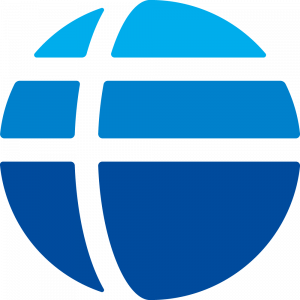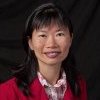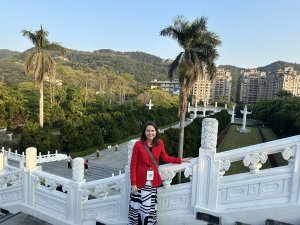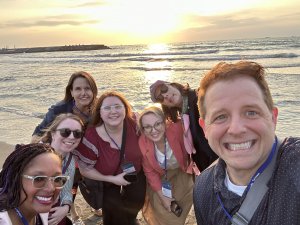Project Background
This year has marked a new milestone in my academic career by becoming a Fulbright Senior Scholar and embarked on a new research on promoting digital equity in Taiwan. I had the privilege to work with researchers in three host universities at National Sun Yat-sen University and Cheng Hsiu University of Science and Technology in Kaohsiung and Fu Jen University in Taipei.

The topic of my project is “Promoting Digital Equity through the E-Tutor Program.” The E-Tutor Program is a nation-wide program implemented by the Ministry of Education in Taiwan, aiming to bridge the educational divide among students in the urban and rural schools. This program was implemented in 1996. The model is to recruit university student tutors to work with students in remote areas by means of video-conferencing through one-to-one learning. On average there are 1,000 e-tutors from 20 universities and 1,000 e-tutees from 95 K-12 schools and educational agents participating in the E-Tutor Program annually.
I am interested in learning various models to bridge the educational divide around the globe. The E-Tutor Program has a great reputation and that’s why I was interested in learning more about what this program has achieved and what kind of opportunities and challenges were faced by the former e-tutees. Most importantly of all, what are the long-term impacts on students who have gone through the program? I utilized a case study approach to interview 17 former e-tutees who are now senior high school or university students. I also interviewed four university tutors and five K-12 school teachers on their perceptions of the E-Tutor Program.

E-Tutor Program Annual Meeting 2015

E-Tutors at Yunlin University of Science and Technology

E-Tutee in a typical videoconferencing session
Research Findings
The results were phenomenal. The E-Tutor Program is a well-structured project that mobilizes university faculty, administrative assistants, university students, K-12 teachers, and the local educational bureaus in each major city in Taiwan to ensure equitable delivery of learning opportunities for students in remote areas. Many skeptics wonder how video-conferencing would work for remote schools. It actually has worked quite well. Many of the schools are in remote mountains and islands, not accessible by public transportation.
By utilizing video-conferencing, the students have a chance to reach the world that goes beyond the confine of their classrooms and communities. They have a place to hang out twice a week for ten weeks each semester to meet with e-tutors who are like big brothers and sisters. The e-tutor’s constant presence provides companionship and academic learning opportunities that they would not have otherwise acquired. As a result of the program, many former e-tutees indicated that they had forged long-term friendship with their tutors, found life directions, and aspired to give back to their community just like the way their tutors have given to their community.

Wutai Elementary School in Pingtung

Students during recess at Sheng Xian Elementary School
I think the project is important because it provides a solid model on how the digital divide could be bridged through partnership between government, universities, and social enterprises. It shows that bridging digital divide or educational divide is more than just providing hardware and software. We also need to have quality tutors, culturally-relevant instructional materials, thoughtful school teachers, and leaders who are willing to break the status quo to try something new.
The E-Tutor Program started out as a project to provide after-school learning, but it has quickly evolved to combine academic learning with companionship through personalized learning opportunity. Each e-tutee was typically assigned with an e-tutor for the whole semester. An e-tutor used the first two sessions to assess the assigned e-tutee on his/her strengths and weaknesses in different academic subjects (usually math, English, or reading) and then mapped out a semester-long study plan for the e-tutee. In each session, an e-tutor would start with asking areas of concerns that an e-tutee might have to decide on the focus for the night before following a study plan.
An e-tutor might use review questions, PowerPoint, videos, or multimedia instructional materials to engage an e-tutee in learning. If an e-tutee showed little interest, an e-tutor might utilize games and other active learning strategies to encourage the learner. In a typical 90-minute session, an e-tutor would reserve at least 10 minutes to chat with the student about happenings in daily life. Oftentimes, an e-tutor got to know the family background, interests, and hobbies of an e-tutee very well. Through the trust-building process of companionship, tutees could be motivated to put in more effort in learning.
It’s also a process of self-realization for the tutors who are learning how to teach, how to motivate a young student, and how to be a role model. Most important of all, the privileged university students learned that there is a divided Taiwan and there’s so much they can give to help a child to reach his/her learning potentials. It’s a win-win situation for both university students and K-12 students.
To explain the types of companionship that the e-tutees have experienced, here are a few quotes by different the e-tutees:
-The companionship is more important than academic learning. They can motivate us to learn through deep caring and support.
-They shared their personal experiences, especially on how to deal with relationship with other people. For example, my tutor would give me advice on how to handle a situation in which I just had an argument with someone.
-In addition to learning, we are not limited to our own world. Our world intersects with the tutor’s world. The two worlds together expand our world views.
Many e-tutees shared insights on the impacts of the E-Tutor Program in the following quotes:
-The impacts are learning a lot of things and understanding that I have a choice to move to high school or university. I want to give back to my community to help other people to go to college.
-I found my purpose in life. I have a clearer goal for school, friendship, and life.
Taiwan’s E-Tutor Program provides a unique model in enhancing educational equity without the barriers of race, socio-economic status, and geographical locations. While there are many successful initiatives around that world aiming at enhancing educational equity through technology, Taiwan’s model is successful because it is a great example of how all stake holders, including government agencies, academics, K-12 educators, and business organizations can work together to enrich the lives of young learners. This model can be replicated in many communities in the world, including the United States. My research will provide practical insights on how we can work together to promote digital equity.

With host professor Dr. Ji-Chyuan Yang and Dr. Yi-song Shi of Cheng Shiu University and Curriculum Director at Wutai Elementary School in Pingtung.

Getting equipment ready at Wutai Elementary School in Pingtung

E-Tutor Program Delivery Model
Through my research, I visited many universities and K-12 schools. Wherever I went, I promoted Fulbright and encouraged Taiwanese scholars and students to look into grant opportunities so that they can come to America to advance their learning or research agenda. Through the support of Fulbright Foundation, I have gained new knowledge on ways to promote digital equity and I have been disseminating the information through scholarly publications and conference presentations. Many students in my research told me that the E-Tutor Program had changed their lives. I believe that if the United States can learn from Taiwan’s experiences, we can change many lives of students in the United States as well.

Meeting with the Dr. Jui-Chang Kung, President of Cheng Shiu University
 Seminar at National Cheng Kung University in Tainan
Seminar at National Cheng Kung University in Tainan
Office at National Sun Yat-Sen University
Roadblocks
There were not many roadblocks during my stay in Taiwan. If I have to name one, it would be finding enough research subjects at the beginning. Since I was studying the impact of the E-Tutor Program on the lives of the former e-tutees, it was hard to find them because they were spread out all over Taiwan. Luckily, I had three host universities and partners who helped me with gaining access to the K-12 teachers who stayed in touch with their students. That’s how I slowly gained access to the subjects. I wrote many emails and made many phone calls to establish the initial contacts. Most people responded to me regardless if they were available for an interview or not. I think being a Fulbright Senior Scholar gave me the key to many doors. I am grateful for it.
Host Universities
Taiwan has excellent scholars and devoted educators who work hard to make it a better place for the students. I am deeply touched by what I have witnessed and encountered. All three host universities provided me excellent resources and research teams to assist me in my research. I enjoyed the process of bouncing ideas back and forth with my collaborators.
 With host professor Tzuhan Lu from Fu Jen University
With host professor Tzuhan Lu from Fu Jen University With host professor Dr. Hsueh-Hua Chuang and research team at National Sun Yat-Sen University
With host professor Dr. Hsueh-Hua Chuang and research team at National Sun Yat-Sen UniversityMemorable Moments
The Neimen Junior High School visit was a highlight during my stay in Taiwan. Through an interview with a local principal, I learned that the school was interested in establishing international collaboration partnership. I happened to know a Fulbright grantee who was planning to bring a group of high school students to Kaohsiung for a study abroad program, so I helped to arrange a school visit for the American high schoolers to visit Neimen Junior High School. The American students could practice Chinese and gain insight to Taiwan’s unique school cultures other than visiting major attractions. The Taiwanese students could learn more about American culture through conversations and activities with the American students. On the day of arrival, all students at the school put up a great performance call Song Jiang Battle Array, which is a very unique Taiwanese cultural practice, to welcome the American students. The American students were able to participate in the array and practice some of the movements together. I thought it was an eye opening experience for both parties. I am glad to be able to help with promoting both American and Taiwanese cultures through this type of exchange program.

With 2015-16 fellow Fulbright Senior Scholars

Welcome performance by the Neimen Junior High School Song Jiang Battle Array
Conclusion
My incentive to apply for the Fulbright Scholarship was to work on a book project on digital equity. I had learned about the E-Tutor Program through Internet search. This government-run initiative is very different from most US projects in terms of the scale and partnership, so I decided to study the program to examine the factors that contribute to a successful digital equity initiative and how it is different from a US model. I have definitely gained new insights and would love to continue working on case studies in different countries. The project in Taiwan has laid a solid foundation for future research and I am grateful for the opportunity.
 With son at Fulbright Mid-Year Conference learning about Chinese opera
With son at Fulbright Mid-Year Conference learning about Chinese opera
Post Views: 4,630





